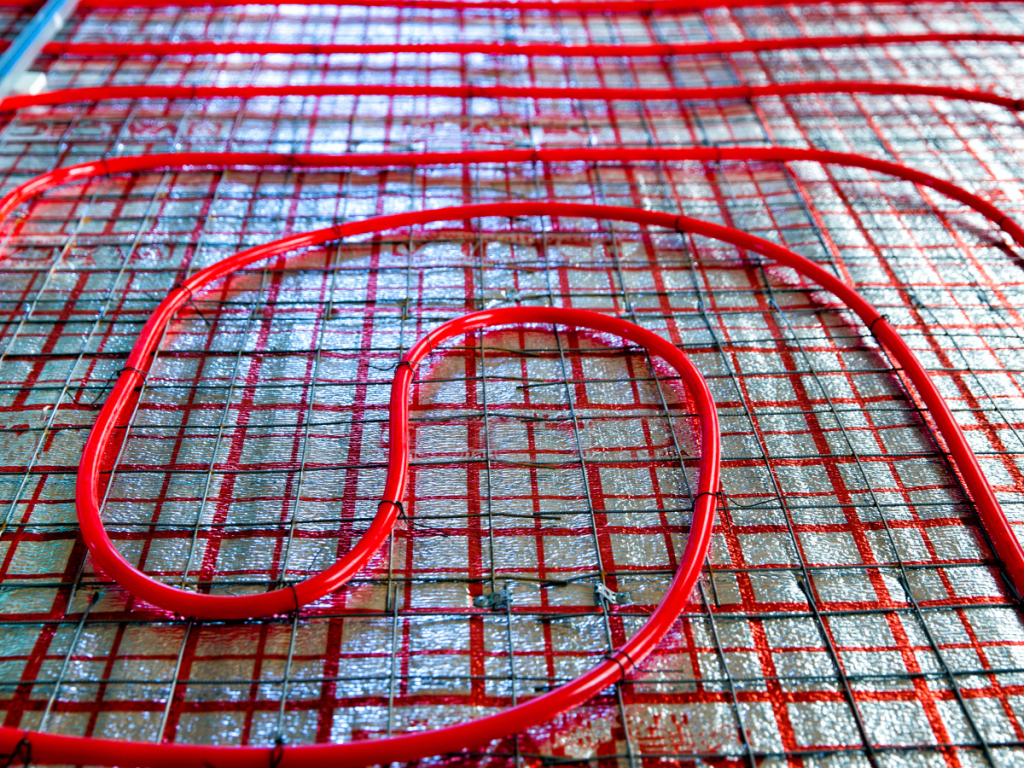Radiant floor heating is a popular method of heating for homeowners due to its efficiency in heat distribution. However, problems with this system can crop up from time to time, disrupting performance.
Let’s go over some common problems with radiant floor heater systems and provide practical solutions to fix them.
Whether you’re experiencing uneven heating, cold spots, or thermostat issues though, Plumb-Tech has you covered. If you find yourself dealing with any of these problems, don’t hesitate to get in touch with us.
Without further ado, let’s dive in!
Radiant floor heating explained
Before getting into common issues, let’s review what exactly radiant floor heating is.
Radiant floor heating is a system that uses radiant heat transfer to warm up the floor, providing consistent warmth to your home. This system offers several advantages compared to traditional methods, such as greater energy efficiency and silent operation.
Common issues experienced by homeowners who use radiant floor heating
Here are some potential problems that may arise and the steps you can take to address them effectively.
- Uneven heating
Uneven heating is one of the most common issues experienced by homeowners. Some areas of the floor may feel warmer than others, leading to discomfort and inefficient heat distribution.
Several factors can contribute to this problem, including improper installation, air bubbles in the pipes, or a malfunctioning zone valve.
To fix this issue, it’s crucial to identify the underlying cause. Start by checking the system’s water pressure and flow rate. Ensuring proper water flow is essential for even heat distribution.
If the problem persists, consult a professional for heating services so they can inspect your system and make any necessary adjustments or repairs.
- Cold spots
Cold spots occur when certain areas of the floor fail to heat up as expected. This can be caused by a variety of factors, such as air trapped in the system or clogged pipes.
To address cold spots, check for any air bubbles in the system and have a professional bleed the pipes if necessary. Additionally, you can ensure that the pipes are not clogged with debris or sediment by having regular maintenance performed.
- Noises coming from the system
If you notice unusual noises, such as gurgling or banging sounds, it may indicate trapped air or water flow issues. Air trapped in the system can disrupt proper water circulation and lead to noisy operation.
To resolve this problem, have a technician bleed the air out of the system by opening the air vents or using a bleed key. It’s essential to have a professional do the job to ensure safe and effective air bleeding.
- Leaks
Leaks can cause significant damage and compromise performance. These leaks can occur due to pipe corrosion, faulty connections, or accidental damage during construction or renovation.
If you suspect a leak, it’s crucial to act promptly. Start by checking all visible connections and inspecting the floor for any signs of moisture or damage.
If a leak is identified, contact a professional plumber to repair or replace the affected components and prevent further damage.
- High energy bills
While radiant floor heating is known for its energy efficiency, a sudden increase in energy bills can indicate an underlying problem. Inefficient operation, heat loss, or thermostat issues can contribute to higher energy consumption.
To address high energy bills, start by checking the thermostat settings and ensuring they’re properly programmed. The thermostat serves as the control center for your radiant floor heating system. Problems with the thermostat can lead to inaccurate temperature readings, improper heat distribution, or system malfunctions.
Also check the thermostat’s batteries and replace them if needed. Ensure it’s properly calibrated and programmed according to your desired settings.
Regular maintenance (such as cleaning or replacing air filters and inspecting the system for any leaks or inefficiencies) can also help improve energy efficiency.
If the issue persists, consult a professional to perform a thorough inspection and make any necessary adjustments.
- Inadequate insulation
Insufficient insulation can significantly impact the performance of your radiant floor heating system. Without proper insulation, heat loss can occur, leading to inefficient operation and increased energy consumption.
To address inadequate insulation, consider adding insulation beneath the floor to prevent heat loss. Consult a professional to determine the most suitable insulation materials and installation methods for your specific flooring type and system setup.
- Incompatibility with floor coverings
Certain floor coverings, such as thick carpets or highly conductive materials, can interfere with the performance of radiant floor heating systems. These coverings can impede heat transfer or cause uneven heating.
If you’re experiencing compatibility issues, consider using floor coverings that are more conducive to radiant floor heating, such as tile, hardwood, or laminate flooring. These materials allow for better heat transfer and distribution, ensuring optimal system performance.
Contact Plumb-Tech for assistance!
Radiant floor heating offers exceptional comfort and energy efficiency, but it’s important to be aware of potential problems that may arise. By understanding common issues like uneven heating, cold spots, thermostat problems, and inadequate insulation, you can take the necessary steps to resolve them effectively.
Regular maintenance, prompt repairs, and professional guidance can ensure that your system operates optimally and provides consistent warmth throughout your home.
For expert assistance with your radiant floor heating system or any other plumbing needs in Missoula, Montana, contact Plumb-Tech today. Our skilled technicians are ready to provide reliable solutions and keep your home comfortable throughout the year.
Contact Plumb-Tech for all your plumbing needs today!





